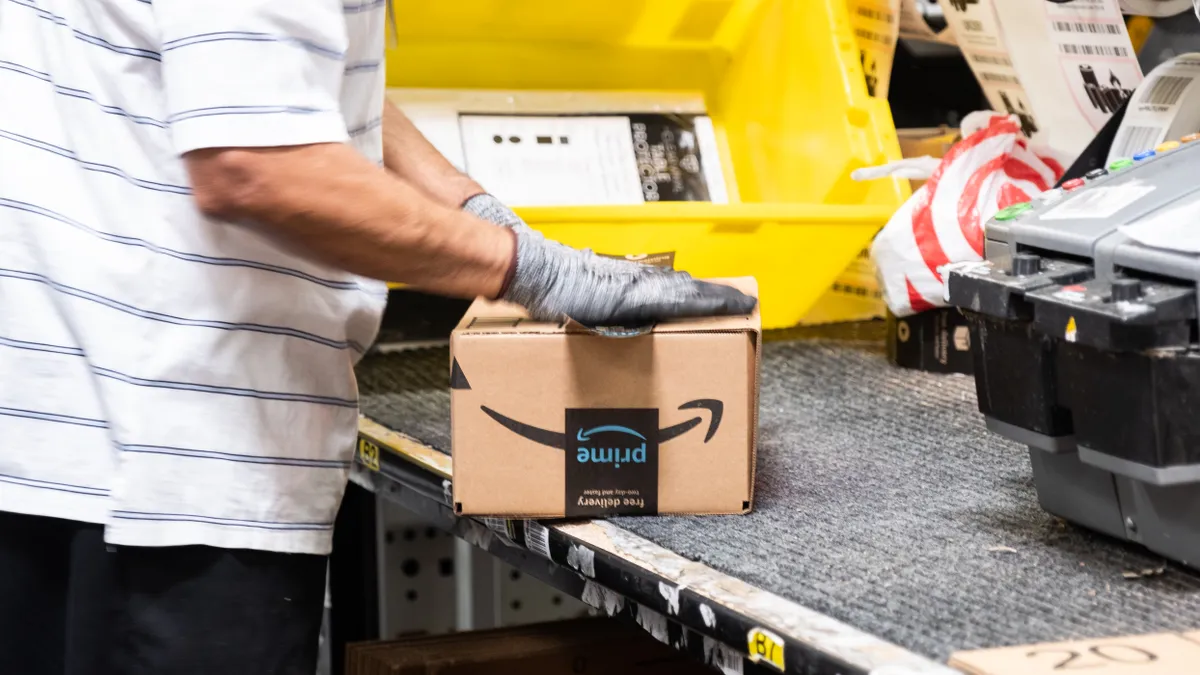Employers have already read signs proclaiming now is the time to prepare the workforce for technological change. On July 11, that message got delivered via cardboard box.
Amazon's Upskilling 2025 training investment announcement sparked coverage due to its size and scope. The effort totals more than half a billion dollars over the next six years and impacts 100,000 employees. But equally important to the price tag may be the audience that investment will serve. Experts who spoke to HR Dive said the inclusion of transportation, retail store and fulfillment center workers signaled a new kind of training mentality.
"Amazon is essentially raising the bar," Frank Britt, CEO of online learning provider Penn Foster, told HR Dive in an interview. The upskilling pledge sends a sign to competitors and others that the company is serious about preparing the workforce for change, he added.
Visibility for middle-skill employees
The announcement comes at a difficult time for those in "middle-skill" jobs — those that require education beyond what is taught in high schools but not a traditional, four-year college degree. Technological and economic change have not only led to a decline in the number of those types of jobs, but have also made those that remain less profitable and stable, Brookings Institution Senior Fellow Marcela Escobari said in a May presentation.
Training has been floated by observers as a way to provide workers in middle-skill jobs a path forward, but employers haven't invested much in this type of training. According to a 2018 report by the Association for Talent Development, employers spent an average of $1,296 per employee on training in 2017, yet the top two areas of training spend were managerial and supervisory training and mandatory and compliance training.
Employers spent an average of $1,296 per employee on training in 2017.

Association for Talent Development
Upskilling those in middle-skill positions is a "third pillar that has not really existed at scale," Britt said, and the spending for such initiatives often pales in comparison to how much is invested in training for white-collar positions. "Most public companies don't even announce what's going on in that pillar, because it's not a significant amount," Britt added.
Viewed in context with similar investments by other retail heavyweights like Walmart, which rolled out education benefits as well as virtual reality training for store associates, Britt said Amazon's initiatives point to a more progressive view about the value of middle-skill talent generally.
Focus on digital jobs
Amazon associates that particpate in Upskilling 2025 will be training for positions in technology-focused fields, including machine learning, software engineering and information technology. For some of the programs, a degree isn't required, Amazon said in a statement.
The details of the announcement showed Amazon is looking to provide workers different kinds of learning pathways to new careers, not just upskilling by itself, Jonathan Finkelstein, founder and CEO of digital credentialing company Credly, told HR Dive in an interview.
"I think you see a range of different kinds of programs," Finkelstein said of his impressions reading the announcement. "Amazon has the opportunity not only to be a model for upskilling initiatives … but they can also be a model for an ecosystem with how to interact with different players."
"Amazon has the opportunity not only to be a model for upskilling initiatives … but they can also be a model for an ecosystem with how to interact with different players."

Jonathan Finkelstein
Founder and CEO, Credly
Those players include Amazon employees themselves; the company's Machine Learning University, one of the six programs highlighted in the announcement, is taught by 400 of Amazon’s own machine learning specialists.
The range of training being offered by Amazon also reflects the data-driven nature of future jobs, at least in the minds of those in the business of determining what the future of work looks like, according to Finkelstein. "We have an economy that relies more heavily on data and the insights that can be drawn from it," he said, noting Amazon took signals for training priorities not just from its internal needs but also from those of its customers.
Moreover, the investment is a sign that Amazon believes middle-skill workers can do the work, Britt said. "They're really making a commitment that middle-skill jobs can make a shift in a digital economy."
A new motive for building training programs?
Jobs in Amazon fulfillment centers are exactly the roles that researchers at Brookings previously labeled as easily automatable, creating potential challenges for communities that have improved their economic performance on the backs of e-commerce companies.
With limited training budgets, employers may find it difficult to invest in workers in these positions in the same way. Still, Finkelstein believes there's enough data to show that training can improve the bottom line by increasing engagement and productivity. It can also serve as a recruiting tool. "People are looking for a place to learn as much as they are a place to work," he said.
"This is an arms race where workers win."

Frank Britt
CEO Penn Foster
On a broader level, the push for skill development is also about the need to address issues like skills gaps and the decline of middle-skill work in a progressive way, both Britt and Finkelstein said. Those who benefit from Amazon's program may leave the company, but Britt said that doesn't necessarily mean the company will view its efforts as a wasted investment.
"The old mentality is a zero-sum game," Britt said. "The new mentality is that I'm going to build a bigger, stronger workforce."
And while Amazon's move may seem like a larger play for better brand perception, especially at a time when the company faces criticism on employment issues ranging from its safety conditions to its culture, Britt said that corporate social responsibility is likely more of a by-product than an end goal of the initiative, given similar moves by other large companies.
"This is an arms race where workers win," Britt said.





















